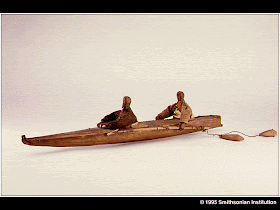
Aleut model of a two-man baidarka (or kayak) from the Commander Islands, Russia, collected in 1891 by N.M. Tilman. Made of wood, gutskin, bone, fabric, and glass beads. Vladivostok Maritime Museum, Russia, #2305. 49 cm. Courtesy Smithsonian Institute.

Three Siberian Skin-Kayak types: (Front to back) Koryak, Maritime Chukchi, and the Inland Chukchi.
Replicas built by Harvey Golden.

Waldemar Jochelson, courtesy American Museum of Natural History
Russian involvement in the history and documentation of the kayak is a rich and deep story. Indeed, it is almost certain that the kayak's birthplace was Siberia. The Russians also had a long history in Alaska. establishing trade and missionary outposts and building churches, many of which are still in evidence today such as this one in Juneau. George Dyson has a great overview of the Russian presence in North America in his book Baidarka. A great number of Russian ethnologists were to study kayak and their surrounding culture both in Siberia and North America. Three of the more interesting Russian ethnographers who studied kayak as part of their field work both in Siberia and North America were Waldemar Jochelson, Vladimir Bogorav and Lev Sternberg. All three were members of a revolutionary and terrorist group in Czarist Russia called the Peoples Will. All three were exiled to Siberia where they began to study the indigenous population. Their work was impressive enough to land them places in the Sibirakov Expedition of 1894-95 to the Yakut Provinces of northeastern Siberia. Jochelson and Bogoras also took part in the Jesup North Pacific Expedition (1897-1902),doing fieldwork in Siberia. Each eventually emigrated to the US.
The Jesup expedition was a major anthropological undertaking on both sides of the North Pacific. Sponsored by Morris Jesup, then president of the American Museum of Natural History, and planned and directed by Franz Boaz, and pursuing fieldwork all around the Bering Straits, it goal was to explore the relationship between the Siberian and North American indigenous peoples of this entire region. Many prominent anthropologists of the day were active in the expedition which produced a great number of ethnologies, collected material culture and photographic records.
This was the period of great exploration and study of cultures around the globe. The period from around 1800 to 1920 saw huge efforts to explore, study, catalogue and colonize the rest of world by the Western powers. Fortunately, the rise of the museum and the collections that fill them means we have great access to indigenous skin on frame kayaks of this period. Those of you who would like to dig deeper can find two great jumping off places in the aforementioned annotated bibliography by David Zimmerly and Harvey Golden's Kayak Data page which locates the source of every replica he's built. You might also enjoy this piece by French anthropologist Joelle Robert-Lamblin on the Aluet boats. Concerning the relationship of boat to man he states "in the Aleut oral tradition, the kayak is not an object; it is a living being, male, a hunting partner which attempts to identify itself with its master and would like to share his married life. Their fates, indeed, are bound up together, and their lives end at the same time: they disappear at sea together or, on land, share the same grave."
No comments:
Post a Comment